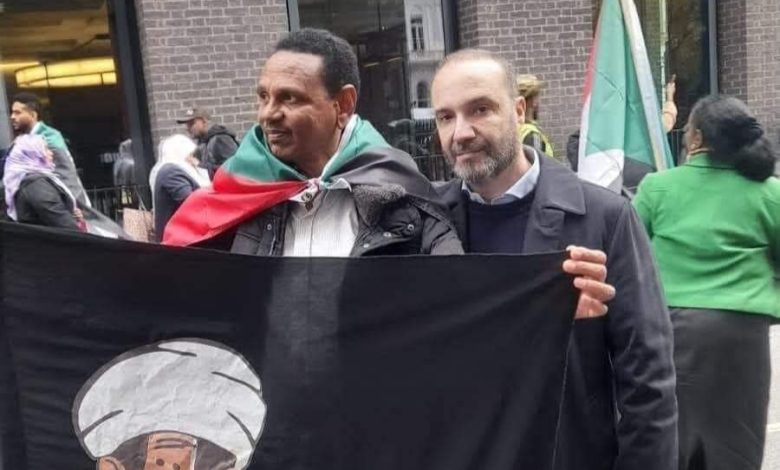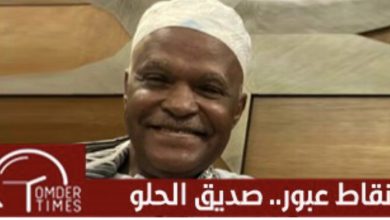المسيرة المؤيدة للحرب في تشاتام هاوس هولي هاستينجز – صحفي مستقل

لقد شهدت لندن، التي تشتهر بتاريخها المفعم بالحياة في مجال السلام، مشهداً غير مألوف هذا الأسبوع: مظاهرة مؤيدة للحرب أمام تشاتام هاوس، إحدى المؤسسات الرئيسية في المدينة للشؤون الدولية.
شهدت العاصمة البريطانية، علي مر السنين، عدداً لا يحصى من التجمعات المناهضة للحرب، من مسيرات مليونية لتحالف أوقفوا الحرب ضد غزو العراق إلى المظاهرات الأسبوعية التي تدين العنف المستمر في غزة. ظلت الاحتجاجات العامة في المدينة توحد الناس في معارضة الحرب، وتروج للسلام والحلول الدبلوماسية. لكن المسيرة التي جرت أمام تشاتام هاوس كسرت هذا القالب، حيث دعت إلى دعم العمل العسكري والتحالف مع الدكتاتورية العسكرية في السودان، في عرض يتناقض بشكل صارخ مع روح لندن المناهضة للحرب منذ فترة طويلة . فقد تجمع مجموعة من المحتجين، بعضهم يرتدي زياً عسكرياً، للتعبير عن دعمهم للقوات المسلحة السودانية. ورددوا شعارات باللغة العربية، بما في ذلك “جيش واحد، شعب واحد”، وهي عبارة ترمز إلى الولاء للقيادة العسكرية السودانية. حدثت هذه المظاهرة في ظل خلفية قاتمة: الصراع الدموي المستمر في السودان، والذي أودى بحياة عشرات الآلاف من المدنيين وشرّد حوالي 10 ملايين شخص على مدى الأشهر السبعة عشر الماضية.
جاء توقيت المظاهرة المؤيدة للحرب استفزازيًا بشكل كبير، حيث تزامن مع حدث في تشاتام هاوس حضره الدكتور عبد الله حمدوك، رئيس وزراء السودان السابق والمدافع البارز عن السلام في المنطقة. جاء الدكتور حمدوك لمناقشة سبل وقف إطلاق النار والاستراتيجيات المحتملة لحل سياسي سلمي للصراع السوداني. الاحتجاج في الخارج كان بمثابة تذكير واضح بالانقسامات العميقة داخل المجتمع السوداني والتحديات التي يواجهها الساعين للسلام.
عكست هذه المظاهرة التعقيدات والديناميكيات المتغيرة داخل الشتات السوداني واثارت تساؤلات حول دور الدعوة في الصراعات التي تمتد إلى ما هو أبعد من الحدود. بالنسبة للندن، فهي تمثل انحرافًا فريدًا ومزعجًا عن تقاليد المدينة العزيزة في بناء السلام. مع استمرار الصراع السوداني، تؤكد أحداث مثل هذه على الحاجة الملحة إلى إيجاد حل، ليس فقط لمنع المزيد من الخسائر في الأرواح ولكن للحفاظ على روح الاحتجاج السلمي التي حددت منذ فترة طويلة الأماكن العامة في لندن.
لقد أصبح المشهد في المظاهرة متوتراً مع تزايد وجود الشرطة، حيث كان الضباط يراقبون عن كثب بينما أصبحت الاحتجاجات غير منضبطة وعنيفة. اثارت المظاهرة المؤيدة للحرب أسئلة ملحة حول الحق في الاحتجاج وحدود مثل هذا التعبير عندما يتقاطع مع الدعوة إلى العنف. وقف تقليد لندن للنشاط السلمي في تناقض صارخ مع التجمع خارج تشاتام هاوس، مذكراً الجميع أنه في حين تحمي الديمقراطية حرية التعبير، فإنها تدعم أيضًا قيم السلام والأمان.
مع استمرار الصراع السوداني، تسلط حوادث مثل هذه الضوء على الحاجة الملحة إلى حل سلمي – وإعادة تأكيد إرث لندن المناهض للحرب.
هولي هاستينجز
صحفي مستقل
The Pro-war rally at Chatham House
London, renowned for its vibrant history of peace activism, saw an unusual sight this week: a pro-war demonstration in front of Chatham House, one of the city’s key institutions for international affairs. Over the years, the British capital has witnessed countless anti-war gatherings, from the Stop the War Coalition’s million-strong march against the Iraq invasion to the weekly demonstrations condemning the ongoing violence in Gaza. The city’s public protests have traditionally united people in opposition to war, promoting peace and diplomacy. However, the rally in front of Chatham House broke this mould, advocating support for military action and aligning with Sudan’s military dictatorship.
In a display that stood in stark contrast to London’s longstanding anti-war ethos, a group of protesters some dressed in military fatigues assembled to voice support for the Sudanese Armed Forces. They chanted slogans in Arabic, including “One army, one people,” a phrase emblematic of allegiance to the Sudanese military leadership. The demonstration occurred amid a grim backdrop: Sudan’s ongoing civil conflict, which has claimed tens of thousands of civilian lives and displaced around 10 million people over the past 17 months.
The timing of the pro-war demonstration was particularly provocative, as it coincided with an event at Chatham House featuring Dr. Abdalla Hamdok, Sudan’s former Prime Minister and a prominent advocate for peace in the region. Dr. Hamdok was there to discuss avenues for ceasefire and potential strategies for a peaceful political resolution to the Sudanese conflict. The protest outside, however, served as a stark reminder of the deep divisions within Sudanese society and the challenges facing those working for peace.
This demonstration reflects the complexities and shifting dynamics within the Sudanese diaspora and raises questions about the role of advocacy in conflicts that extend beyond borders. For London, it represents a unique and troubling departure from the city’s cherished tradition of peace activism. As the Sudanese conflict drags on, events like these underscore the urgency of finding a resolution, not only to prevent further loss of life but to preserve the ethos of peaceful protest that has long defined London’s public spaces.
The scene at the demonstration grew tense as police presence increased, with officers keeping a close watch as the protest reportedly became unruly and violent. The pro-war demonstration raises pressing questions about the right to protest and the limits of such expression when it intersects with advocacy for violence. London’s tradition of peaceful activism stood in stark contrast to the gathering outside Chatham House, reminding all that while democracy protects free speech, it also upholds values of peace and safety. As the Sudanese conflict rages on, incidents like this one highlight the urgent need for a peaceful resolution—and a reaffirmation of London’s anti-war legacy.
Holy Hastings
Freelance Journalist






